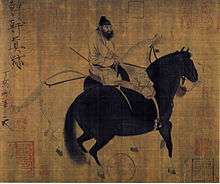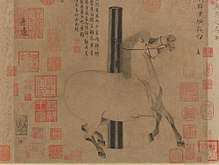Han Gan
Han Gan (Chinese: 韩干/韓幹) (c. 706-783) was a Chinese painter during the Tang Dynasty.


| Wikimedia Commons has media related to Han Gan. |
He came from a poor family in either Chang'an, modern-day Xi'an, Shaanxi; Lantian, modern-day Shaanxi; or Daliang, modern-day Kaifeng, Henan. As a young man, Han Gan was recognized by Wang Wei, a prominent poet, who sponsored Han in learning arts. Han became a student of Cao Ba, a court painter.[1] After his studies, Han became a painter in the Tang court.
Han painted many portraits and Buddhistic themed paintings during his career; however, he is most widely remembered for his paintings of horses. He was reputed to have "learned from the horses in the imperial stables"[2] and to be able to not only portray the physical body of the horse, but also its spirit. His reputation rose and surpassed that of his teacher. Horse painters of later generations studied Han.
References
- "Archived copy". Archived from the original on 2013-01-11. Retrieved 2013-06-26.CS1 maint: archived copy as title (link)
- James Cahill. The Painter's Practice: How Artists Lived and Worked in Traditional China, New York: Columbia University Press, 1994. p. 98.
- T.J. Mahoney (18 November 2013). Mercury. Springer Science & Business Media. p. 71. ISBN 978-1-4614-7951-2.